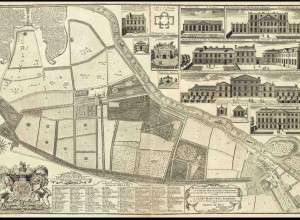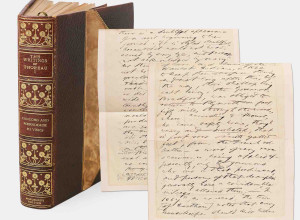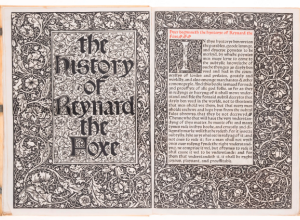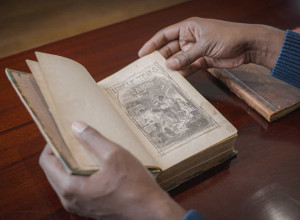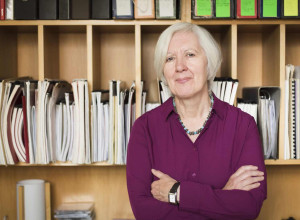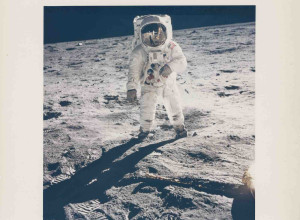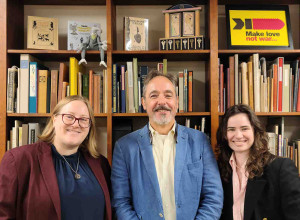"It's Alive! Frankenstein at 200" Opens at the Morgan Library in October
New York — A classic of world literature, a masterpiece of horror, and a forerunner of science fiction, Frankenstein by Mary Shelley is the subject of a new exhibition at the Morgan. Organized in collaboration with the New York Public Library, It’s Alive! Frankenstein at 200 traces the origins and impact of the novel whose monster has become both a meme and a metaphor for forbidden science, unintended consequences, and ghastly combinations of the human and the inhuman. Portions of the original manuscript will be on display along with historic scientific instruments and iconic artwork such as Henry Fuseli’s Nightmare and the definitive portrait of Mary Shelley. The story’s astonishingly versatile role in art and culture over the course of two hundred years helps explain why the monster permeates the popular imagination to this day.
Co-curated by John Bidwell, the Astor Curator and Department Head of the Morgan’s Printed Books and Bindings Department, and Elizabeth Denlinger, Curator of the Carl H. Pforzheimer Collection of Shelley and His Circle at The New York Public Library, this exhibition presents a diverse array of books, manuscripts, posters, prints, and paintings illustrating the long cultural tradition that shaped and was shaped by Mary Shelley’s myth. A large number of these works come from both the Morgan and the New York Public Library’s collections.
Only eighteen years old when she embarked on the novel, Shelley invented the archetype of the mad scientist who dares to flout the laws of nature. She created an iconic monster who spoke out against injustice and begged for sympathy while performing acts of shocking violence.The monster’s fame can be attributed to the novel’s theatrical and film adaptations. Comic books, film posters, publicity stills, and movie memorabilia reveal a different side to the story of Frankenstein, as reinterpreted in spinoffs, sequels, mashups, and parodies.
“The Morgan is in an excellent position to tell the rich story of Mary Shelley’s life and of Frankenstein’s evolution in popular culture,” said director of the museum, Colin B. Bailey. “Pierpont Morgan was fascinated by the creative process, and one of the artifacts he acquired was a first edition Frankenstein annotated by the author. The collection of works by the Shelleys, both at the Morgan and the New York Public Library, has only grown since then. We are very pleased to collaborate with the NYPL in presenting the full version of this extraordinary tale and how it lives on in the most resilient and timely of ways.”
A copiously illustrated companion volume, It’s Alive! A Visual History of Frankenstein, provides a vivid account of the artistic and literary legacy of the novel along with detailed descriptions of the highlights in the exhibition, while a new online curriculum offers high school teachers resources for the classroom.
The Exhibition
The exhibition occupies two galleries: one documenting the life of Mary Shelley and the composition of her book, the other showing how the story evolved in the theater, cinema, and popular culture.
The Influence of the Gothic Style and Enlightenment Science
Mary Shelley’s Frankenstein; or, The Modern Prometheus sprang from both a passion for Gothic style that pervaded British culture long before the author’s birth in 1797 and the influence of the discoveries of European Enlightenment science. Audiences loved the supernatural in all its formulations—ghosts, graveyards, mysterious strangers, secret warnings, lost wills, hidden pictures, and more. While novels were the primary vehicle for the Gothic, it was also popular with artists of paintings and prints, which were sometimes satirical —the Gothic was parodied as soon as it was taken seriously. The exhibition opens with the greatest horror painting of the eighteenth century, The Nightmare, painted in 1781by the Swiss immigrant artist Henry Fuseli. Mary Shelley knew about this iconic image and may have used it in writing the climactic scene in Frankenstein.
Shelleywas also influenced by the scientific endeavors of the time. She had been born into an age of scientific and technological discovery in Britain, when institutions like the Royal Society began fostering exploration and experimentation. Across Britain spread a thriving circuit of lectures and science demonstrations for the public. A few of these experiments have become part of the Frankenstein legend. While writing the novel, Shelley had been reading Humphry Davy’s Elements of Chemical Philosophy, and she knew about anatomical dissections, contemporary debates about the origins of life, and electrical experiments on corpses. She lends this fascination to Victor Frankenstein, who makes a monster from corpses in his “workshop of filthy creation.”
Mary Shelley’s Life and Conception of Frankenstein
Mary Shelley grew up in a radical and intellectual milieu, the daughter of writers famous in their own time, the feminist theorist Mary Wollstonecraft and the novelist and philosopher William Godwin. After her mother died in childbirth, her father married Mary Jane Clairmont, who had children of her own, and the teenaged Mary Godwin escaped a tense family atmosphere by making long visit to friends in Scotland. When she returned in 1814, she met the poet Percy Bysshe Shelley, already married and a father. They soon fell in love and eloped to Europe, the most decisive act of all their lives.
It was on a trip to Lake Geneva in 1816 accompanied by P.B. Shelley, Lord Byron, and her step-sister Claire Clairmont that Mary Godwin found the inspiration to write Frankenstein. During their stay, the party entertained themselves by reading aloud from a volume of Gothic tales. Byron suggested a contest to write ghost stories, and Shelley joined in energetically, looking for something “to curdle the blood, and quicken the beatings of the heart.” After days of frustrated effort, the idea came to her one night after hearing P.B. Shelley and Lord Byron discuss the origins of life and the possibility of animating a corpse by galvanic action. “I saw -with shut eyes, but acute mental vision -I saw the pale student of unhallowed arts kneeling beside the thing he had put together.” She returned to England with the beginnings of a novel
By 1817, she had finished a draft titled Frankenstein; or, The Modern Prometheus. The book appeared in three volumes on January 1, 1818, after P. B. Shelley offered revisions and found a publisher. Luckily for posterity, most of the Frankenstein manuscript has survived, making it possible to see the author’s original ideas, her second thoughts, and her husband’s suggestions. Portions of the manuscript containing key passages in the novel will be on display at the Morgan.
Mary Shelley’s personal life was punctuated by tragedy in ways strangely similar to incidents in the novel. After settling in Italy in the spring of 1818 with her husband, their children William and Clara, step-sister Claire and her daughter Allegra, the family experienced constant sorrow as first William and Clara, and then Allegra died. Their grief was only partly assuaged by the birth of another child, Percy Florence. Through their mourning and marital difficulties, Mary Shelley and her husband maintained a strenuous routine of writing and study and friendships in the English and Italian communities. In July 1822, Shelley suffered a final devastating loss: P. B. Shelley sailed with his friend Edward Williams and their cabin boy to meet their friend Leigh Hunt’s family in Leghorn; on their return their boat met a sudden squall and they drowned.
Frankenstein on Stage and on Screen
When Mary Shelley returned to England in August 1823, one of the few bright spots was Richard Brinsley Peake’s melodrama Presumption! or, the Fate of Frankenstein: a theatrical hit, the play had made her famous. The actor Thomas Potter Cooke’s performance was the key factor: over six feet tall, clad in a gray-blue leotard, his exposed skin painted the same color, with a toga on top, he moved with lyrical athleticism and made the creature both frightening and pathetic. Mary Shelley saw one of Cooke’s performances and enjoyed it greatly. Other adaptations followed: at least fifteen dramas based on the novel were produced between 1823 and 1826.
A large portion of the exhibition is dedicated to the movies, which have played an essential role in popularizing the story and shaping our pop culture image of the monster. The earliest film of Frankenstein was made by the Edison Studios in 1910, but it is James Whale’s 1931 version that has taken such a prominent place in the popular psyche that it is now better known than the novel. The 1931 Frankenstein and 1935 Bride of Frankenstein gave us a radically reimagined version of the narrative, particularly the creation scene and Boris Karloff’s performance as the monster. James Whale and his special effects technicians introduced the high-voltage lab equipment and set the scene amidst the thunder and lightning now obligatory in horror movies. The creature’s violence was induced by his being tortured with fire. Karloff later said, “Over the years thousands of children wrote, expressing compassion for the great, weird creature who was so abused by its sadistic keeper that it could only respond to violence with violence. Those children saw beyond the make-up and really understood.” The 1935 sequel, with Elsa Lanchester playing both Mary Shelley and the creature’s bride, has also aged well. Both films create sympathy for the creature through his encounters with stupid and sadistic people, and both Karloff and Elsa Lanchester portray their characters with dignity and depth of emotion.
From the creation of the monster, to the creature’s killing of a small child, to violence committed against women, adaptations of Frankenstein again and again have returned to some of the most disturbing but recurring scenes of human experience. Mary Shelley’s unique contribution to culture is the creation of the monster. Her genius was to imagine a way to make life out of death; James Whale’s genius was to imagine a way to depict it in moving images and sound.
Whale’s Frankenstein films sparked a mass of cinematic energy. Other directors drew from it for years after with imitations and derivative films, a few just as frightening, some quite funny, none as haunting. The Morgan has borrowed a series of B-movie posters from a private collector and the Academy of Motion Picture Arts and Sciences to show some of the more faithful, comic, lurid, and execrable treatments of this theme
Makeup artists, perhaps, have come closer than anyone to bringing Victor Frankenstein’s story to life. Jack Pierce’s makeup gave the creature a new face in the 1931 film. Some highlights in the section include the sketches and photographs of this iconic appearance along with a gruesome torso model of Robert De Niro in Kenneth Branagh’s Frankenstein, provided by the Harry Ransom Center at the University of Texas, Austin.
The Creature’s Afterlife: Comic Books and Prints
The comic book as a separate slim magazine first appeared in 1933 as a promotional insert in newspapers, and Frankenstein has been part of this medium’s history from nearly the beginning. The exhibition includes some of the most interesting examples of the story, some aimed at children and some at adults.
Surprisingly few illustrators have taken on the novel’s challenge, but we present four of the best: Lynd Ward (remembered first of all as a wood engraver), Bernie Wrightson (a renowned comic book artist), Barry Moser (a celebrated book illustrator), and Pierre-Alain Bertola (a polymath Swiss artist who worked on a theatrical version of Frankenstein). All of them are working after, and against James Whale. All pay exquisite attention to Mary Shelley’s text and its ethical implications.
The exhibition closes with Barry Moser’s illustration of the Frankenstein family tomb, leaving us solidly in the tradition of Gothic art with which the show begins. Mary Shelley’s creature is a Gothic nightmare, but one who takes responsibility for himself. Even as his blood boils at the injustices committed against him, he is also “torn by the bitterest remorse.” Seeking quiet in death, he leaps onto his raft and is soon lost to human eyes. As mysterious and volatile in death as in life, Frankenstein’s monster leaves us with more questions than answers—perhaps the decisive reason why artists have been drawn to him for the past two hundred years.
Publication
It’s Alive! A Visual History of Frankenstein delves into the artistic and literary legacy of the novel and provides detailed descriptions of the highlights in the exhibition. It introduces readers to portrayals of the creature--from his early days dancing across a stage, to Boris Karloff's lurching pathos, to the wide variety of modern-day comic book versions--and of Victor Frankenstein, from brainy college kid to bad scientist, and grounds them in historical context. In addition, it provides full introductions to Mary Shelley's life before and after the novel and to the pioneering scientific work of her day. A full chapter displays the Gothic paintings and graphic art that inspired Shelley's work. The contextual chapters will make it useful to the student and the general reader.





